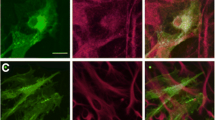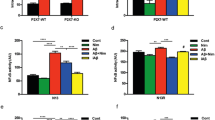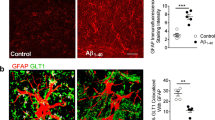Abstract
Microglia can exacerbate central nervous system disorders, including stroke and chronic progressive neurodegenerative diseases such as Alzheimer disease. Mounting evidence points to ion channels expressed by microglia as contributing to these neuropathologies. The Chloride Intracellular Channel (CLIC) family represents a class of chloride intracellular channel proteins, most of which are localized to intracellular membranes. CLICs are unusual in that they possess both soluble and integral membrane forms. Amyloid β-peptide (Aβ) accumulation in plaques is a hallmark of familial Alzheimer disease. The truncated Aβ25-35 species was shown previously to increase the expression of CLIC1 chloride conductance in cortical microglia and to provoke microglial neurotoxicity. However, the highly pathogenic and fibrillogenic full-length Aβ1-42 species was not examined, nor was the potential role of CLIC1 in mediating microglial activation and neurotoxicity by other stimuli (e.g. ligands for the Toll-like receptors). In the present study, we utilized a two chamber Transwell™ cell culture system to allow separate treatment of microglia and neurons while examining the effect of pharmacological blockade of CLIC1 in protecting cortical neurons from toxicity caused by Aβ1-42- and lipopolysaccaride-stimulated microglia. Presentation of Aβ1-42 to the upper, microglia-containing chamber resulted in a progressive loss of neurons over 3 days. Neuronal cell injury was prevented by the CLIC1 ion channel blockers IAA-94 [(R(+)-[(6,7-dichloro-2-cyclopentyl-2,3-dihydro-2-methyl-1-oxo-1H-inden-5yl)-oxy] acetic acid)] and niflumic acid (2-{[3-(trifluoromethyl)phenyl]amino}nicotinic acid) when presented to the upper chamber only. Incubation of microglia with lipopolysaccharide plus interferon-γ led to neuronal cell injury which, however, was insensitive to inhibition by the CLIC1 channel blockers, suggesting a degree of selectivity in agents leading to CLIC1 activation.




Similar content being viewed by others
References
Giovannini MG, Scali C, Prosperi C, Bellucci A, Vannucchi MG, Rosi S, Pepeu G, Casamenti F (2002) β-Amyloid-induced inflammation and cholinergic hypofunction in the rat brain in vivo. Involvement of the p38MAPK pathway. Neurobiol Dis 11:257–274
Barnum CJ, Tansey MG (2010) Modeling neuroinflammatory pathogenesis of Parkinson disease. Prog Brain Res 184:113–132
Boche D, Nicoll JAR (2013) Neuroinflammation in ageing and in neurodegenerative disease. Neuropath Appl Neurobiol 39:1–2
Aguzzi A, Barres BA, Bennett ML (2013) Microglia: scapegoat, saboteur, or something else? Science 339:156–161
Nagatsu T, Mogi M, Ichinose H, Togari A (2000) Changes in cytokines and neurotrophins in Parkinson disease. J Neural Transm Suppl 60:277–290
Dauer W, Przedborski S (2003) Parkinson disease. Mechanisms and models. Neuron 39:889–909
González-Scarano F, Baltuch G (1999) Microglia as mediators of inflammatory and degenerative diseases. Annu Rev Neurosci 22:219–240
Miller G (2005) The dark side of glia. Science 308:778–781
Barcia C, Ros CM, Annese V, Gómez A, Ros-Bernal F, Aguado-Yera D, Martínez-Pagán ME, de Pablos V, Fernandez-Villalba E, Herrero MT (2011) IFN-γ signaling, with the synergistic contribution of TNF-α, mediates cell specific microglial and astroglial activation in experimental models of Parkinson’s disease. Cell Death Dis 2:e142. doi:10.1038/cddis.2011.17
Appel SH, Zhao W, Beers DR, Henkel JS (2011) The microglial-motoneuron dialogue in ALS. Acta Myol 30:4–8
Mitterauer BJ (2011) Possible role of glia in cognitive impairment in schizophrenia. CNS Neurosci Ther 17:333–344
Hinwood M, Morandini J, Day TA, Walker FR (2012) Evidence that microglia mediate the neurobiological effects of chronic psychological stress on the medial prefrontal cortex. Cereb Cortex 22:1442–1454
Rosano C, Marsland AL, Gianaros PJ (2012) Maintaining brain health by monitoring inflammatory processes: a mechanism to promote successful aging. Aging Dis 3:16–33
Skaper SD (2011) Ion channels on microglia: therapeutic targets for neuroprotection. CNS Neurol Disorders Drug Targets 10:44–56
Murzin AG (2008) Biochemistry. Metamorphic proteins. Science 320:1725–1726
Warton K, Tonini R, Fairlie WD, Matthews JM, Valenzuela SM, Qiu MR, Wu WM, Pankhurst S, Bauskin AR, Harrop SJ, Campbell TJ, Curmi PM, Breit SN, Mazzanti M (2002) Recombinant CLIC1 (NCC27) assembles in lipid bilayers via a pH-dependent two-state process to form chloride ion channels with identical characteristics to those observed in Chinese hamster ovary cells expressing CLIC1. J Biol Chem 277:26003–26011
Littler DR, Harrop SJ, Fairlie WD, Brown LJ, Pankhurst GJ, Pankhurst S, DeMaere MZ, Campbell TJ, Bauskin AR, Tonini R, Mazzanti M, Breit SN, Curmi PM (2004) The intracellular chloride ion channel protein CLIC1 undergoes a redox-controlled structural transition. J Biol Chem 279:9298–9305
Singh H, Ashley RH (2006) Redox regulation of CLIC1 by cysteine residues associated with the putative channel pore. Biophys J 90:1628–1638
Goodchild SC, Howell MW, Cordina NM, Littler DR, Breit SN, Curmi PM, Brown LJ (2009) Oxidation promotes insertion of the CLIC1 chloride intracellular channel into the membrane. Eur Biophys J 39:129–138
Valenzuela SM, Alkhamici H, Brown LJ, Almond OC, Goodchild SC, Carne S, Curmi PM, Holt SA, Cornell BA (2013) Regulation of the membrane insertion and conductance activity of the metamorphic chloride intracellular channel protein CLIC1 by cholesterol. PLoS ONE 8:e56948. doi:10.1371/journal.pone.0056948
Valenzuela SM, Martin DK, Por SB, Robbins JM, Warton K, Bootcov MR, Schofield PR, Campbell TJ, Breit SN (1997) Molecular cloning and expression of a chloride ion channel of cell nuclei. J Biol Chem 272:12575–12582
Ulmasov B, Bruno J, Woost PG, Edwards JC (2007) Tissue and subcellular distribution of CLIC1. BMC Cell Biol 8:8. doi:10.1186/1471-2121-8-8
Berry KL, Bulow HE, Hall DH, Hobert O (2003) A C. elegans CLIC-like protein required for intracellular tube formation and maintenance. Science 302:2134–2137
Littler DR, Harrop SJ, Brown LJ, Pankhurst GJ, Mynott AV, Luciani P, Mandyam RA, Mazzanti M, Tanda S, Berryman MA, Breit SN, Curmi PM (2007) Comparison of vertebrate and invertebrate CLIC proteins: The crystal structures of Caenorhabditis elegans EXC-4 and Drosophila melanogaster DmCLIC. Proteins 71:364–378
Elter A, Hartel A, Sieben C, Hertel B, Fischer-Schliebs E, Luttge U, Moroni A, Thiel G (2007) A plant homolog of animal chloride intracellular channels (CLICs) generates an ion conductance in heterologous systems. J Biol Chem 282:8786–8792
Jiang L, Salao K, Li H, Rybicka JM, Yates RM, Luo XW, Shi XX, Kuffner T, Tsai VW, Husaini Y, Wu L, Brown DA, Grewal T, Brown LJ, Curmi PM, Breit SN (2012) Intracellular chloride channel protein CLIC1 regulates macrophage function through modulation of phagosomal acidification. J Cell Sci 125:5479–5488
Novarino G, Fabrizi C, Tonini R, Denti MA, Malchiodi-Albedi F, Lauro GM, Sacchetti B, Paradisi S, Ferroni A, Curmi PM, Breit SN, Mazzanti M (2004) Involvement of the intracellular ion channel CLIC1 in microglia-mediated beta-amyloid-induced neurotoxicity. J Neurosci 24:5322–5330
Milton RH, Abeti R, Averaimo S, DeBiasi S, Vitellaro L, Jiang L, Curmi PM, Breit SN, Duchen MR, Mazzanti M (2008) CLIC1 function is required for β-amyloid-induced generation of reactive oxygen species by microglia. J Neurosci 28:11488–11499
Kaminsky YG, Marlatt MW, Smith MA, Kosenko EA (2010) Subcellular and metabolic examination of amyloid-β peptides in Alzheimer disease pathogenesis: evidence for Aβ25–35. Exp Neurol 221:26–37
Scheuner D, Eckman C, Jensen M, Song X, Citron M, Suzuki N, Bird TD, Hardy J, Hutton M, Kukull W, Larson E, Levy-Lahad E, Viitanen M, Peskind E, Poorkaj P, Schellenberg G, Tanzi R, Wasco W, Lannfelt L, Selkoe D, Younkin S (1996) Secreted amyloid β-protein similar to that in the senile plaques of Alzheimer’s disease is increased in vivo by the presenilin 1 and 2 and APP mutations linked to familial Alzheimer’s disease. Nat Med 2:864–870
Skaper SD, Facci L (2012) Central nervous system neuron-glia co-culture models. Methods Mol Biol 846:79–89
Facci L, Skaper SD (2012) Culture of rodent cortical and hippocampal neurons. Methods Mol Biol 846:49–56
Skaper SD, Argentini C, Barbierato M (2012) Culture of neonatal rodent microglia, astrocytes, and oligodendrocytes from cortex and spinal cord. Methods Mol Biol 846:67–77
Culbert AA, Skaper SD, Howlett DR, Evans NA, Facci L, Soden PE, Seymour ZM, Guillot F, Gaestel M, Richardson JC (2006) MAPKAP kinase 2 deficiency in microglia inhibits pro-inflammatory mediator release and resultant neurotoxicity: Relevance to neuroinflammation in a transgenic mouse model of Alzheimer’s disease. J Biol Chem 281:23658–23667
Evans NA, Facci L, Owen DE, Soden PE, Burbidge SA, Prinjha RK, Richardson JC, Skaper SD (2008) Aβ1-42 reduces synapse number and inhibits neurite outgrowth in primary cortical and hippocampal neurons: a quantitative analysis. J Neurosci Meth 175:96–103
Manthorpe M, Fagnani R, Skaper SD, Varon S (1986) An automated colorimetric microassay for neuronotrophic factors. Dev Brain Res 25:191–198
Facci L, Skaper SD (2012) Amyloid β-peptide neurotoxicity assay using cultured rat cortical neurons. Methods Mol Biol 846:57–65
Hussain I, Harrison DC, Hawkins J, Chapman T, Marshall I, Facci L, Ahmed S, Brackenborough K, Skaper SD, Mead TL, Smith BB, Giblin GM, Hall A, Gonzalez MI, Richardson JC (2011) TASTPM mice expressing amyloid precursor protein and presenilin-1 mutant transgenes are sensitive to γ-secretase modulation and amyloid-β42 lowering by GSM-10 h. Neurodegener Dis 8:15–24
Golde TE, Younkin SG (2001) Presenilins as therapeutic targets for the treatment of Alzheimer’s disease. Trends Mol Med 7:264–269
Tomita T, Iwatsubo T (2004) The inhibition of γ-secretase as a therapeutic approach to Alzheimer’s disease. Drug News Perspect 17:321–325
Lambert MP, Barlow AK, Chromy BA, Edwards C, Freed R, Liosatos M, Morgan TE, Rozovsky I, Trommer B, Viola KL, Wals P, Zhang C, Finch CE, Krafft GA, Klein WL (1998) Diffusible, nonfibrillar ligands derived from Aβ1-42 are potent central nervous system neurotoxins. Proc Natl Acad Sci USA 95:6448–6453
Hughes JP, Ward DR, Facci L, Richardson JR, Skaper SD (2010) Apoptosis-associated tyrosine kinase and neuronal cell death. Neurochem Res 35:588–597
Tulk BM, Schlesinger PH, Kapadia SA, Edwards JC (2000) CLIC-1 functions as a chloride channel when expressed and purified from bacteria. J Biol Chem 275:26986–26993
Liantonio A, Giannuzzi V, Picollo A, Babini E, Pusch M, Conte Camerino D (2007) Niflumic acid inhibits chloride conductance of rat skeletal muscle by directly inhibiting the CLC-1 channel and by increasing intracellular calcium. Br J Pharmacol 150:235–247
Picollo A, Liantonio A, Babini E, Camerino DC, Pusch M (2007) Mechanism of interaction of niflumic acid with heterologously expressed kidney CLC-K chloride channels. J Membr Biol 216:73–82
Golde S, Chandran S, Brown GC, Compston A (2002) Different pathways for iNOS-mediated toxicity in vitro dependent on neuronal maturation and NMDA receptor expression. J Neurochem 82:269–282
Cushman DW, Cheung HS (1976) Effect of substrate concentration on inhibition of prostaglandin synthetase of bull seminal vesicles by anti-inflammatory drugs and fenamic acid analogs. Biochim Biophys Acta 424:449–459
Eikelenboom P, Bate C, Van Gool WA, Hoozemans JJ, Rozemuller JM, Veerhuis R, Williams A (2002) Neuroinflammation in Alzheimer’s disease and prion disease. Glia 40:232–239
Parvathenani LK, Tertyshnikova S, Greco CR, Roberts SB, Robertson B, Posmantur R (2003) P2X7 mediates superoxide production in primary microglia and is up-regulated in a transgenic mouse model of Alzheimer’s disease. J Biol Chem 278:13309–13317
Skaper SD, Facci L, Culbert AA, Evans NA, Chessell I, Davis JB, Richardson JC (2006) P2X7 receptors on microglial cells mediate injury to cortical neurons in vitro. Glia 54:234–242
Meyer-Luehmann M, Spires-Jones TL, Prada C, Garcia-Alloza M, de Calignon A, Rozkalne A, Koenigsknecht-Talboo J, Holtzman DM, Bacskai BJ, Hyman BT (2008) Rapid appearance and local toxicity of amyloid-beta plaques in a mouse model of Alzheimer’s disease. Nature 451:720–724
Craft JM, Watterson DM, Van Eldik LJ (2005) Neuroinflammation: a potential therapeutic target. Expert Opin Ther Targets 9:887–90053
Vasilevko V, Xu F, Van Previti ML, Nostrand WE, Cribbs DH (2007) Experimental investigation of antibody-mediated clearance mechanisms of amyloid-β in CNS of Tg-SwDI transgenic mice. J Neurosci 27:13376–13383
Parachikova A, Agadjanyan MG, Cribbs DH, Blurton-Jones M, Perreau V, Rogers J, Beach TG, Cotman CW (2007) Inflammatory changes parallel the early stages of Alzheimer disease. Neurobiol Aging 28:1821–1833
Oddo S, Caccamo A, Tran L, Lambert MP, Glabe CG, Klein WL, Laferla FM (2006) Temporal profile of amyloid-β (Aβ) oligomerization in an in vivo model of Alzheimer disease. A link between Aβ and tau pathology. J Biol Chem 281:1599–1604
Paradisi S, Matteucci A, Fabrizi C, Denti MA, Abeti R, Breit SN, Malchiodi-Albedi F, Mazzanti M (2008) Blockade of chloride intracellular ion channel 1 stimulates Aβ phagocytosis. J Neurosci Res 86:2488–2498
Averaimo S, Milton RH, Duchen MR, Mazzanti M (2010) Chloride intracellular channel 1 (CLIC1): Sensor and effector during oxidative stress. FEBS Lett 584:2076–2084
Lin MT, Beal MF (2006) Mitochondrial dysfunction and oxidative stress in neurodegenerative diseases. Nature 443:787–795
Lustbader JW, Cirilli M, Lin C, Xu HW, Takuma K, Wang N, Caspersen C, Chen X, Pollak S, Chaney M, Trinchese F, Liu S, Gunn-Moore F, Lue LF, Walker DG, Kuppusamy P, Zewier ZL, Arancio O, Stern D, Yan SS, Wu H (2004) ABAD directly links Aβ to mitochondrial toxicity in Alzheimer’s disease. Science 304:448–452
Yao J, Du H, Yan S, Fang F, Wang C, Lue LF, Guo L, Chen D, Stern DM, Gunn Moore FJ, Xi Chen J, Arancio O, Yan SS (2011) Inhibition of amyloid-β (Aβ) peptide-binding alcohol dehydrogenase-Ab interaction reduces Aβ accumulation and improves mitochondrial function in a mouse model of Alzheimer’s disease. J Neurosci 31:2313–2320
Crouch PJ, Blake R, Duce JA, Ciccotosto GD, Li QX, Barnham KJ, Curtain CC, Cherny RA, Cappai R, Dyrks T, Masters CL, Trounce IA (2005) Copper-dependent inhibition of human cytochrome c oxidase by a dimeric conformer of amyloid-β1-42. J Neurosci 25:672–679
Manczak M, Anekonda TS, Henson E, Park BS, Quinn J, Reddy PH (2006) Mitochondria are a direct site of Aβ accumulation in Alzheimer’s disease neurons: implications for free radical generation and oxidative damage in disease progression. Hum Mol Genet 15:1437–1449
Casley CS, Canevari L, Land JM, Clark JB, Sharpe MA (2002) β-amyloid inhibits integrated mitochondrial respiration and key enzyme activities. J Neurochem 80:91–100
Gibson GE, Sheu KF, Blass JP, Baker A, Carlson KC, Harding B, Perrino P (1988) Reduced activities of thiamine-dependent enzymes in the brains and peripheral tissues of patients with Alzheimer’s disease. Arch Neurol 45:836–840
Gibson GE, Blass JP, Beal MF, Bunik V (2005) The α-ketoglutarate-dehydrogenase complex: a mediator between mitochondria and oxidative stress in neurodegeneration. Mol Neurobiol 31:43–63
Parker WD, Filley CM, Parks JK (1990) Cytochrome oxidase deficiency in Alzheimer’s disease. Neurology 40:1302–1303
Schilling T, Eder C (2011) Amyloid-β-induced reactive oxygen species production and priming are differentially regulated by ion channels in microglia. J Cell Physiol 226:3295–3302
Kaneko YS, Ota A, Nakashima A, Mori K, Nagatsu I, Nagatsu T (2012) Regulation of oxidative stress in long-lived lipopolysaccharide-activated microglia. Clin Exp Pharmacol Physiol 39:599–607
Tonini R, Ferroni A, Valenzuela SM, Warton K, Campbell TJ, Breit SN, Mazzanti M (2000) Functional characterization of the NCC27 nuclear protein in stable transfected CHO-K1 cells. FASEB J 14:1171–1178
Valenzuela SM, Mazzanti M, Tonini R, Qiu MR, Warton K, Musgrove EA, Campbell TJ, Breit SN (2000) The nuclear chloride ion channel NCC27 is involved in regulation of the cell cycle. J Physiol (Lond) 3:541–552
Acknowledgments
L. Facci is the recipient of a fellowship from Fondazione CARIPARO “Progetto Dottorati di Ricerca” Anno 2009.
Author information
Authors and Affiliations
Corresponding author
Rights and permissions
About this article
Cite this article
Skaper, S.D., Facci, L. & Giusti, P. Intracellular Ion Channel CLIC1: Involvement in Microglia-Mediated β-Amyloid Peptide(1-42) Neurotoxicity. Neurochem Res 38, 1801–1808 (2013). https://doi.org/10.1007/s11064-013-1084-2
Received:
Revised:
Accepted:
Published:
Issue Date:
DOI: https://doi.org/10.1007/s11064-013-1084-2




